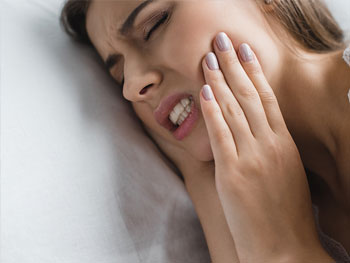TMJ dysfunction (TMD) causes pain and tenderness in your jaw joints and surrounding muscles and ligaments. Causes include teeth grinding, jaw injuries, arthritis and everyday wear and tear. TMJ treatment varies from person to person and may include medication, physical therapy, custom mouth guards and jaw surgery.
What is TMJ dysfunction?
TMJ dysfunctions are conditions affecting your jaw joints and surrounding muscles and ligaments. These conditions can cause several issues, including jaw pain, headaches and difficulty opening and closing your mouth.
You might hear people call these conditions TMJ. But “TMJ” refers to your actual jaw joint, while “TMD” stands for temporomandibular joint dysfunction. Another name is temporomandibular joint disorder.
You have two TMJs (temporomandibular joints) — one on each side of your face, just in front of your ears. Your TMJs connect your lower jawbone to your skull and help with movements like chewing and speaking.
Between 5% and 12% of the general adult population have some form of TMJ disorder. The condition is twice as common in women and people assigned female at birth (AFAB) than in men and people assigned male at birth (AMAB). People between the ages of 20 and 40 are most likely to develop TMD.

Types of TMD (temporomandibular joint dysfunction)
Healthcare providers classify TMDs into three categories:
- Disorders of your jaw joints.
- Disorders of your chewing muscles.
- Headaches that result from TMD.
Symptoms and Causes
What are the symptoms of TMJ dysfunction?
TMJ symptoms vary widely and may include:
- Jaw pain.
- Facial pain.
- Shoulder or neck pain.
- Stiffness in your jaw.
- Difficulty opening or closing your mouth.
- Jaw popping or clicking.
- Headaches.
- Migraines.
- Earaches.
- Toothache.
- Tinnitus (ringing in your ears).
- A change in the way your teeth fit together (malocclusion).
What is the main cause of TMJ dysfunction?
There’s no singular cause of TMD. Rather, it can be a result of many different factors or a combination of factors.
TMJ causes may include:
- Jaw injury (like a broken or dislocated jaw).
- Teeth grinding or clenching (bruxism).
- Arthritis in your jaw joint.
- Malocclusion (when your teeth don’t fit together exactly as they should).
- Stress.
Things that make TMJ dysfunction worse
You can’t always control factors that cause TMJ dysfunction. But certain habits can make TMD worse, including:
- Using your teeth as tools (like tearing off clothing tags).
- Poor posture. (This can place excess pressure on your neck, shoulder and facial muscles.)
- Chewing on pens, pencils or other items (a common “nervous habit” behavior).
- Chewing on ice or excessively chewing gum.
- Taking big bites of food. (This can overwork your jaw muscles.)
- Daytime teeth clenching or grinding.
- Sleeping on your stomach.
What are the complications of TMJ dysfunction?
TMJ dysfunction can contribute to a range of complications, including chronic pain, limited chewing function and bruxism-related wear and tear.
Some factors can overlap, and it may be difficult to identify the exact cause. In some cases, it can take a while to find a treatment that works well for you.
Diagnosis and Tests
How do healthcare providers diagnose temporomandibular joint dysfunction (TMD)?
Healthcare providers can diagnose TMJ disorder during a dental checkup or physical examination. During this visit, they’ll:
- Observe your range of motion when you open and close your mouth.
- Press on your face and jaw to find areas of discomfort.
- Feel around your jaw joints while you open and close your mouth.
They may also take imaging tests to get a closer look at your jaw joints and the structures around them. These imaging tests may include:
- Dental X-rays.
- CT (computed tomography) scans.
- MRI (magnetic resonance imaging).
- TMJ arthroscopy (used for diagnosis and, in some cases, treatment).
Management and Treatment
How do healthcare providers treat TMJ dysfunction?
The TMJ treatment that’s right for you depends on several factors, including the underlying cause and the severity of your pain. Providers usually try noninvasive options first, like medications or nonsurgical treatments. If your symptoms don’t improve, you might need jaw surgery.
Medication
There are several types of over-the-counter (OTC) and prescription medications that can ease TMJ symptoms, including:
- Pain relievers like acetaminophen.
- Nonsteroidal anti-inflammatory drugs (NSAIDs) like ibuprofen and naproxen.
- Muscle relaxers (particularly helpful for people who clench or grind their teeth).
- Antidepressants (which can change how your body interprets pain).
Some medications, including antidepressants, can actually cause bruxism (teeth grinding or clenching). Be sure to talk to your healthcare provider about the risks vs. benefits of certain medications.
Nonsurgical TMJ treatments
Nonsurgical treatment options include:
- Mouth guards. Dental appliances like oral splints or mouth guards can place your jaw in a more favorable position or help reduce the effects of grinding and clenching. While you can buy these over the counter, it’s best to get a custom mouth guard from a dentist.
- Physical therapy. This includes TMJ exercises to stretch your jaw and strengthen the muscles around your jaw joints.
- Trigger point injections. This involves either dry needling or injecting substances (like corticosteroids or botulinum toxin) into painful muscle knots in your jaw.
- Ultrasound therapy. This treatment uses sound waves to deliver heat deep into your tissues. It increases blood flow and promotes muscle relaxation.
- Transcutaneous electrical nerve stimulation (TENS). This method uses low-level electrical currents to relax your jaw muscles.
- Behavioral changes. This includes things like improving your posture and avoiding chewing on ice.
Surgical TMJ treatments
If medications and nonsurgical therapies don’t work, you might need surgery. Types of TMJ surgery include:
- Arthrocentesis. Providers often use this to find out why your jaw joint is sore. But during this procedure, they can also use a needle to remove fluid from your joint and ease your symptoms.
- TMJ arthroscopy. A surgeon makes a small incision just in front of your ear and inserts a thin tube that has a light and camera. (You might hear providers call this keyhole surgery.) They can insert surgical instruments through the tube to reshape bone, remove scar tissue or reposition the disk in your joint.
- Open-joint surgery. When keyhole surgery isn’t an option, a surgeon can perform open-joint surgery. This requires a long incision so that your surgeon can access your jaw joint directly.
Who treats TMJ disorder?
TMJ specialists include:
- Oral surgeons.
- Orthodontists.
- Otolaryngologists.
- Prosthodontists (dentists specializing in dental prostheses and appliances).
Prevention
Can I prevent TMJ dysfunction?
You can’t always prevent TMD because some risk factors are unavoidable. But there are things you can do to reduce your risk:
- Wear a mouth guard at night if you clench or grind your teeth.
- Wear a mouth guard while playing contact sports.
- Practice good posture.
- Practice meditation, mindfulness or other stress reduction techniques.
Outlook / Prognosis
What can I expect if I have TMJ dysfunction?
TMJ dysfunction affects everyone differently. For some, it’s a temporary issue that goes away in a week or two. For others, it’s a chronic condition that negatively impacts quality of life.
If you have frequent jaw pain, facial pain, headaches or other TMJ symptoms, tell a healthcare provider. They can help you find an effective treatment.
How long does TMJ dysfunction last?
It depends. In some cases, TMD goes away on its own in one to two weeks. But in severe instances, it can last several months or even years. TMJ disorder can be short term (acute) or long term (chronic).
Can TMJ disorder be cured?
Yes, it’s possible to cure TMJ dysfunction with appropriate treatment and management.
Living With
When should I see my healthcare provider?
If you have persistent TMJ pain, popping jaws or other symptoms, schedule a visit with a healthcare provider. They can help you find out why your jaws are aching and determine what kind of treatment you need.
What questions should I ask my healthcare provider?
If you have TMJ dysfunction, here are some questions you might want to ask your healthcare provider:
- What caused this?
- Will it go away?
- Do I need TMJ treatment?
- What’ll happen if I don’t seek treatment?
TMJ dysfunction affects everyone differently. It can result in temporary discomfort or chronic jaw pain that lasts for months or even years. While the condition can be difficult to diagnose, there are treatments that can help. If you have jaw pain, headaches or other symptoms that keep you from enjoying life, talk to your healthcare provider. They can find the cause and recommend appropriate treatment.







